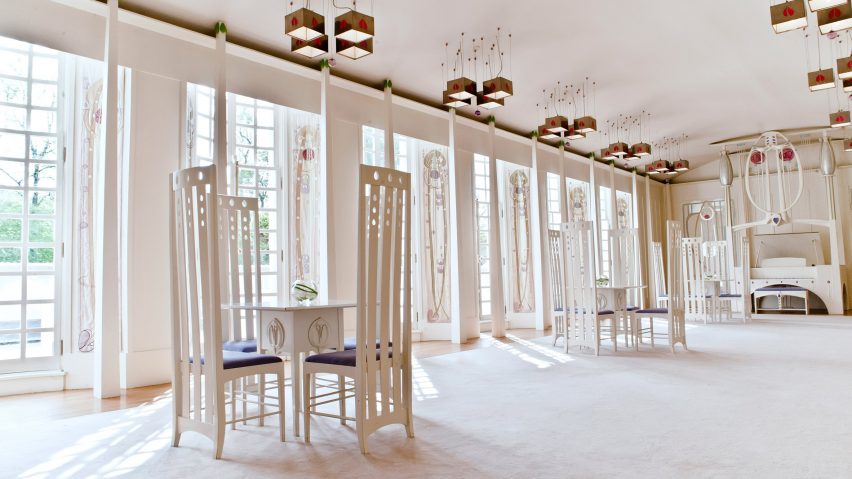
"Mackintosh's wide-ranging work reminds us how specialised architecture has become"
This week marked the 150th anniversary of Charles Rennie Mackintosh's birthday. But the Scottish architect would not be amused by the quality of Glasgow's new architecture, says Richard Murphy.
We can only marvel today at the dexterity of Charles Rennie Mackintosh's generation. The architect could turn his hand to anything. But in those years, and for some time after, that was not actually unusual.
I remember sitting in Alvar Aalto's 1937 rooftop Savoy restaurant in Helsinki and realising that he had designed everything: the interior, the furniture, the carpet, the lights, the ironmongery, the cutlery, the glassware and the crockery.
Mackintosh's work, so wide-ranging, reminds us how narrow and specialised we have become today, and how the design of a building is too often divided up, with only a project manager in full control.
Just as remarkable as his incredible creativity is the human story, of early successes balanced by failure during his later life, and the years of neglect and indifference from his home city of Glasgow after his death. The sudden reawakening that followed has swung the pendulum so far in the other direction that the city is festooned in what is known locally as "mockintosh" – a kitsch branding exercise that in every way dishonours his memory.
How many times has creative talent had to find recognition abroad before acceptance at home?
A BBC documentary made by Lachlan Goudie, to mark the 150th anniversary of Mackintosh's birth, begins in Vienna railway station, describing how the Mackintoshes (Margaret's role as a creative partner was for once not undervalued) had been feted on their arrival in 1900. Their carriage was decked with flowers and pulled by students though the streets of the city to an exhibition of their work in the Secession. It then shows the pain of returning home to Glasgow where they were, frankly, nobody's.
This seems to be a reoccurring British phenomenon, particularly acute in Scotland. Seventy years later, Glasgow was indifferent to the extraordinary office of Gillespie Kidd & Coia and allowed them to wither on the vine. And how many times has creative talent had to find recognition abroad (usually Germany) before acceptance at home? Jim Stirling's second career was almost entirely as a result of German clients. More recently, there was the amusing story of German chancellor Angela Merkel introducing David Chipperfield to UK prime minister Theresa May as "one of Germany's finest architects."
Of course, one of the great enigmas of Mackintosh's neglect is how he would have developed in the 20s and 30s as mainstream modernism took off. Eighteen years the junior to Joseph Hoffman and three years younger than Gunnar Asplund, he nonetheless was eclipsed by their rapid development in that era. Only the tiny 1916 project at 78 Derngate in Northampton gives us a hint of what might have been, had he both received commissions and survived cancer to live and work beyond 1928.
The tiny 1916 project at 78 Derngate in Northampton gives us a hint of what might have been, had Mackintosh both received commissions and survived cancer
The revival of Mackintosh's reputation can be traced, I believe, to filmmaker Murray Grigor's BBC documentary in 1968. Screened at the Venice Film Festival, it alerted a new generation of architects to his work, leading to Arata Isozaki, Hans Hollein and others making the pilgrimage to Glasgow.
Among them was Bruno del Priore, a young Italian architecture student, who made drawings of Mackintosh's chairs. This eventually led to an exhibition in Milan and the agreement by Cassina to reproduce the classic designs in exchange for a royalty to the Glasgow School of Art. The chairs of course went viral, propelling Mackintosh to his current international prominence.
Would Mackintosh fare any better in Scotland of today? The omens are not good. Despite the fig leaf of an architecture policy, I doubt if Mackintosh's fate would have been any different. Indeed he could be in a worse position.
The Scottish government and its many agencies have no interest whatsoever in identifying talent let alone encouraging it
Can you imagine being able to secure the commission for the Glasgow School of Art, or Scotland Street School though PQQ and ITT submissions, let along build them though the absurd Hubco system, where the contractor selects the architect, and draw it via the obligatory BIM?
The Scottish government and its many agencies have no interest whatsoever in identifying talent, let alone encouraging it. So it's no surprise that so many talented young Scots automatically head south or abroad to join the large numbers of their expatriate colleagues.
Indeed, as Goudie's film said, Mackintosh would not have been amused to see the quality of the architecture of the new Glasgow. He stands today as a reminder that, despite his own travails, we live in a cultural dark age.